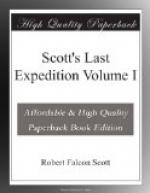If we can get through the ice in the coming effort we may get all the ponies through safely, but there would be no great cause for surprise if we lost two or three more.
These animals are now the great consideration, balanced as they are against the coal expenditure.
This morning a number of penguins were diving for food around and under the ship. It is the first time they have come so close to the ship in the pack, and there can be little doubt that the absence of motion of the propeller has made them bold.
The Adelie penguin on land or ice is almost wholly ludicrous. Whether sleeping, quarrelling, or playing, whether curious, frightened, or angry, its interest is continuously humorous, but the Adelie penguin in the water is another thing; as it darts to and fro a fathom or two below the surface, as it leaps porpoise-like into the air or swims skimmingly over the rippling surface of a pool, it excites nothing but admiration. Its speed probably appears greater than it is, but the ability to twist and turn and the general control of movement is both beautiful and wonderful.
As one looks across the barren stretches of the pack, it is sometimes difficult to realise what teeming life exists immediately beneath its surface.
A tow-net is filled with diatoms in a very short space of time, showing that the floating plant life is many times richer than that of temperate or tropic seas. These diatoms mostly consist of three or four well-known species. Feeding on these diatoms are countless thousands of small shrimps (Euphausia); they can be seen swimming at the edge of every floe and washing about on the overturned pieces. In turn they afford food for creatures great and small: the crab-eater or white seal, the penguins, the Antarctic and snowy petrel, and an unknown number of fish.
These fish must be plentiful, as shown by our capture of one on an overturned floe and the report of several seen two days ago by some men leaning over the counter of the ship. These all exclaimed together, and on inquiry all agreed that they had seen half a dozen or more a foot or so in length swimming away under a floe. Seals and penguins capture these fish, as also, doubtless, the skuas and the petrels.
Coming to the larger mammals, one occasionally sees the long lithe sea leopard, formidably armed with ferocious teeth and doubtless containing a penguin or two and perhaps a young crab-eating seal. The killer whale (Orca gladiator), unappeasably voracious, devouring or attempting to devour every smaller animal, is less common in the pack but numerous on the coasts. Finally, we have the great browsing whales of various species, from the vast blue whale (Balaenoptera Sibbaldi), the largest mammal of all time, to the smaller and less common bottle-nose and such species as have not yet been named. Great numbers of these huge animals are seen, and one realises what a demand they must make on their food supply and therefore how immense a supply of small sea beasts these seas must contain. Beneath the placid ice floes and under the calm water pools the old universal warfare is raging incessantly in the struggle for existence.




